Cultural Property News thanks author Peter K. Tompa for making possible the following abridgment of commentary submitted to Congress in 2004 as commentary on proposed legislation introduced but not passed into law, H.R. 4641[1], the Cultural Conservation of the Crossroads of Civilization Act. This abridged commentary provides a useful introduction to the types of coins found in Afghanistan, their origin, their extraordinary numbers, and their circulation throughout the ancient world and in modern trade. The original commentary was submitted on behalf of the Ancient Coin Collectors Guild (ACCG)[2], the International Association of Professional Numismatists (IAPN)[3], and the Professional Numismatists Guild (PNG)[4], three nonprofit organizations dedicated to the lawful and ethical trade and collecting of ancient coins.
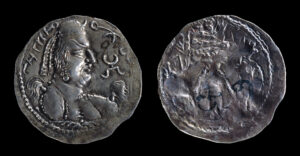
Dinar of the Alchon Huns, c. 300–500 C.E., silver, found at Hadda Stupa 10, Afghanistan, © Trustees of the British Museum.
Afghanistan has suffered greatly from tyranny and war, but has there really been a case made that “emergency import restrictions” on antiquities must be imposed, and if so, will any such prescription make the situation better or worse in Afghanistan, and at what cost to the American numismatic community? By their very nature, the import restrictions contemplated will not just impact trade between the US and Afghanistan. Rather, depending on how they are implemented, such restrictions could greatly hamper—and thus damage—all legitimate trade in ancient and early modern historical coins.
Historical coins were struck in the millions and circulated widely in antiquity as hard currency and in more recent times as collectibles. Coins that circulated in Afghanistan cannot be distinguished from those that circulated in Northern India, Pakistan, Central Asia or elsewhere. Now placing the burden of proof on collectors, coin dealers, and museums to show “provenance” could, therefore, “cloud the title” to hundreds of thousands, if not millions, of historical coins already in collections here and abroad. Such coins could not travel in international commerce without fear of unjustified detention and seizure.

Coin of Eucratides I, Afghanistan, Bactria, circa 171-155 B.C. Copper alloy
Purchased with funds provided by Anna Bing Arnold and Justin Dart (M.84.110.4)
South and Southeast Asian Art, Collection Los Angeles County Museum of Art. Wikimedia Commons.
Coins are not national treasures. Until the Communist coup in the late 1970’s, ancient coins were traded freely in Afghanistan. Militia commanders and local people who continue to sell coins presumably believe that they are only following that tradition. Hoards of coins have been found by accident for millennia, but only the recent introduction of the metal detector makes it possible to find coins by design. Regulation of metal detectors is the most effective and fair way of dealing with looting of archaeological sites in search of tiny metal objects like coins. There is little hard information about the true situation in Afghanistan, but it is unlikely that the destitute Afghans who act as diggers even have access to this modern technology in the first place.
Indeed, even if such restrictions make ancient coins worthless as collectibles, it would only encourage destitute Afghans to melt them down to recover their metallic value as bullion! No one—not even the archaeologists—would be served by such a result.
Should America really buy into a “cultural nationalist” perspective that all antiquities belong to the state? That certainly is not the rule here in the US. Nor was it the rule in pre-Communist and pre-Taliban Afghanistan.[5] Yet, this is precisely the underlying theory implicit in an embargo on the import of any Afghan antiquity. Such embargos only encourage foreign states to make the broadest possible claims of ownership of ancient artifacts with troubling consequences both here and abroad. As we have seen from the history of Ba’athist Iraq, broad claims of state ownership over all tangible evidence of the past only helps foster hyper-nationalism and corruption at the highest levels.[6]
Supporting what are in effect confiscatory decrees of a foreign state does nothing to enhance America’s image as a beacon of freedom abroad,[7] particularly where insiders are allowed to profiteer from antiquities sales while the public at large faces the severest of penalties for trading in or collecting even the most minor artifacts.
Facts on Coins from Afghanistan
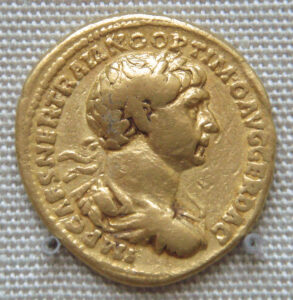
A coin of Trajan, found in the Ahinposh Buddhist monastery in Afghanistan, together with coins of Kanishka. Source/Photographer PHGCOM, Collection of the British Museum, 2007, CCC-SA 3.0 unported license. Wikimedia Commons
Coins reached Afghanistan in the 5th C. BC when it was a province of the Achaemenid Empire of Iran.[8] Early issues of the Greek and Persian cities of the Eastern Mediterranean circulated based on their value as precious metal (bullion). Some of the first coins that circulated in the area included Athenian Tetradrachms. These large silver coins, weighing approximately 17 grams, bear a depiction of the Goddess Athena on the obverse, and her familiar, the Owl, on the reverse. Persian governors (satraps) struck copies of these “Owls” before Alexander conquered the area in 329 BC. Alexander’s successors struck coins in Bactria (Northern Afghanistan).
Many issues are notable for their fine portraiture. Since that time, coins were struck in what is now Afghanistan by the Mauryan Empire, the Kushan Empire, the White Huns, the Turks, the Mongols, and the Savids. Millions of such coins circulated throughout Central Asia, Pakistan and parts of India. In addition, “foreign” coins, like those issued by the Sassanian Persians and Romans, also circulated in the area by the thousands upon thousands. In this regard, it is important to note ancient mintages could be quite large. For example, “Francois de Callatay [a Belgian scholar] has calculated that 28,000,000 Alexander [the Great] drachms were produced in Asia Minor down to 300 B.C.E.; Martin Price [a British scholar] more than doubled that estimate for this single denomination in one region of the empire.”[9]
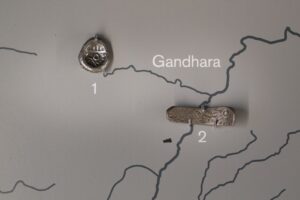
Display of Indian coinage, South Asia (Gandhara detail) British Museum, England, Photo by Anthony Huan, 21 February 2018 CCA-SA 2.0 Generic. Wikimedia Commons
Numismatics, the study of coins, began in the Renaissance. Numismatics remains one of the few academic endeavors where ideas are exchanged freely among collectors, academics and museum professionals. Numismatics predates archaeology by several centuries. Unlike archaeologists, numismatists treat coins as far more than a means to the limited end of dating archaeological sites. Instead, numismatists have interpreted coins as part of a larger political, military and economic context of the society which issued them. Moreover, unlike archaeologists, numismatists also have accepted the obligation to preserve, popularize and display their coins. Much of what we know about the Greek kingdoms present in Afghanistan derives from the study of their coins. These kingdoms have otherwise left little physical evidence for their existence, and, indeed, some Greek kings are only known from their coins.[10]
“Because of the scarcity of ancient texts and of the available archaeological data, numismatic evidence constitutes the main source for the reconstruction of the history of the Greeks and their successors in Bactria and India. Thanks to the coins, we know today the existence of more than 40 different names of Indo-Greek kings, whereas the written sources mention only seven. So the reconstruction of the history of the Greeks in Bactria and India is primarily based on numismatic evidence.”[11]
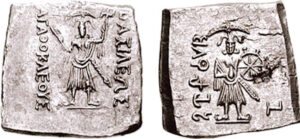
Coin of the Baktrian King Agathokles, written in Brahmi language. The coin shows Hindu deities: Vasudeva-Krishna and Balarama-Samkarshana. Used with permission (CNG coin [1]). Classical Numismatic Group, Inc; Coin ID 57554, CCA-SA 2.5 Generic license. Wikimedia Commons.
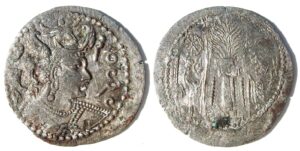
Billon drachm of the Hephthalite King Napki Malka (c. 475-576). Obv: Napki Malka type bust with winged headdress. Pahlavi legend “NAPKI MALKA”. Rev: Zoroastrian fire altar with attendants either side. Sun wheel, or eight-spoked Buddhist Dharmacakra above left. Wikimedia Commons.
The fact that archaeologists mainly find single coins at archaeological sites is of some significance because coins found outside of protective containers are far less likely to be desirable to collectors. Generally speaking, coins embedded in loamy or chalky soil may be well preserved; those found in wet, humid, salty, sandy or acidic environments are likely to be so corroded or abraded as to be unidentifiable.[14]
Collectors, dealers and scholars cooperate on numismatic research. Recent numismatic publications related to coins circulating in the area of modern Afghanistan include Frank Holt, Alexander the Great and the Mystery of the Elephant Medallions (University of California Press 2003) (book by scholar); Arthur Houghton and Catherine Lorber, Seleucid Coins, a Comprehensive Catalog. Part 1: Seleucus I – Antiochus III (ANS and CNG 2002) (book by coin collector and numismatic researcher); Brian Kritt, Seleucid Coins of Bactria, Classical Numismatic Studies No.1 (CNG: Lancaster, PA, 1996) (book by coin dealer); Brian Kritt, Dynastic Transitions in the Coinage of Bactria, Classical Numismatic Studies No. 4 (CNG; Lancaster, PA 2001) (book by coin dealer); R.C. Senior, Coinage of Hermaios & Imitations by Scythians. Classical Numismatic Studies No. 3. (CNG: Lancaster, PA, 2000) (book by coin dealer); R.C. Senior, Indo-Scythian History and Coins. Coinage of the Scythians (2001)(book by coin dealer). In contrast, few coin finds from major sites have been published by archaeologists or scholars working with them.[15]
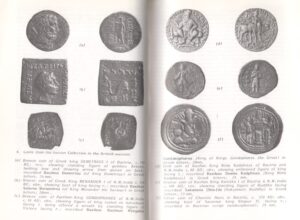
Coins collected by Charles Masson in Afghanistan in the 1820s-30s, now in the British Museum. From Gordon Whitteridge, Charles Masson of Afghanistan, 1986.
Ancient coins struck in Afghanistan have been widely collected and traded since at least the 1800’s. English gentlemen who served with the British colonial administration in India formed many notable collections. As early as 1832, British adventurer Charles Masson began collecting coins in Afghanistan.[16] Masson himself estimated that he collected some 60,000 coins during his travels in the country from 1833-1838.[17] Thereafter, part of this collection was dispersed at auction and part was donated to museums.[18] English collector/scholars also included Dr. Richard Bertram Whitehead (1879-1967). His Notes on Indo-Greek Numismatics[19], gives some sense of the collector spirit of the time, “I record some general observations, based on my sixteen years’ experience as an active collector in the Punjab, on the position and extent of the dominions of the Bactrian Greeks in India under Heliocles and his successors, as deduced more especially from the find spots, distribution, and monograms of their coins.”[20]
Even in recent times, the Afghan government did not treat coins as national treasures. In the pre-Communist era (before1978), ancient coins were sold openly in antiques shops on Chicken Street and Pakistani Embassy Street in Kabul.[21] Traders would also sell thousands of coins in parks where they would be displayed on rugs. For example, ancient Indo-Scythian copper coins sold for 10 Afghanis (about $0.15) each.[22]

Coin found in Ghazni (Turk Shahi), L’Œuvre de la Délégation Archéologique Française en Afghanistan (1922-1932) : vol.1, Published 1933, Author: Joseph Hackin Wikimedia Commons.
There was also a system that allowed officials at the Afghan National Museum to issue export permits. Museum officials did not accept bribes, and issued export permits for “minor works” for a small administrative fee.[23]
Americans have long enjoyed collecting, studying and preserving coin types that circulated in the area of modern Afghanistan. A number of prominent American collectors bought ancient coins in Afghanistan during its heyday as a tourist destination in the 1960’s and early 1970’s. Of course, coins of the type that circulated in Afghanistan have also been available for purchase in the US for many decades. For example, a noted collection formed primarily in the 1940’s and 1950’s by Archaeological Institute of America Trustee and American Numismatic Society (ANS) Council Member Arthur Dewing contained examples of coins issued by Greco-Bactrian and Indo-Scythian rulers.[24]
In the US, both the American Numismatic Society and the Smithsonian Institution also maintain large holdings of Bactrian coins. At the ANS, Harry W. Fowler’s bequest in 1995 added to the already strong holdings of Bactria, so that today the ANS houses an extremely comprehensive collection of Greco-Bactrian and Indo-Greek coins, which was published by scholar Osmund Bopearachchi.[25] Bopearachchi also published another work on the Smithsonian’s collections.[26] Neither of these collections is currently on display, and indeed, the Smithsonian recently announced that it would close its entire display of historical coins.
The Afghan National Museum once held an excellent collection of coins. The museum housed several important hoards of coins excavated by French archaeologists. (There was a close relationship between the French and Afghans. The French received exclusive rights to excavate important sites.) Coins in the museum included coins from the first Mir Zakah Hoard, the Kabul Hoard, and the Qunduz Hoard (627 Graeco-Bactrian coins and imitations), and those from the ruins of Ai Khanoum, and Begram.) Many of the Greek coins were published because they provided some of the best evidence of the presence of Greeks in the area. Nevertheless, with some exceptions (notably a double decadrachma of Amyntas from the Kunduz Hoard (a scarce coin weighing 3.4 ounces)) such coins included types also found outside of Afghanistan and widely available in the trade for decades.
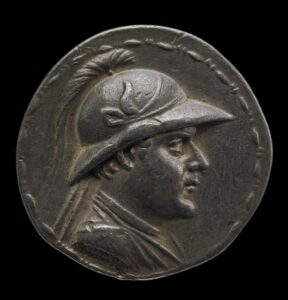
Eucratides I, King of Bactria, Greco-Bactrian, 174 BC-145 BC (circa), copyright Trustees of the British Museum.
The cooperation between museum officials, dealers and collectors that furthered the study of Afghanistan’s numismatic heritage began to change soon after the Communist Coup in 1978. The Communists did not damage the museum, but they built an air field over ruins at Begram. In addition, there was damage to archaeological sites due to bombing during their war with Afghan Mujahideen. The Communists did close down the legitimate antiquities trade, and the important dealers moved to Pakistan, mostly Peshawar and Islamabad. The Communists murdered or imprisoned other dealers and/or members of the museum or archaeological establishment due to real or imagined contact with “Westerners.”[27]
After years of war, in 1992, the Communists were overthrown by a disparate group of militias including the Tajik dominated Northern Alliance. These groups soon fell into fighting amongst themselves. One of the sad aspects of the fighting was that the National Museum was damaged and extensively looted by various commanders. The entire coin collection of ancient Greek and later coins (some 30,000 items) disappeared and is said to have been sold to fund arms purchases.[28] . [Note: Despite fears in 2003 when this document was written that the entire collection had been stolen, it appears that much of the National Museum’s coin collection survived the Taliban’s first rule.[29]]
Dupree wrote: “In 1992, while the various factions fought for control of Darulaman, government soldiers guarded the museum. In early 1993, they were replaced by soldiers loyal to Hezbe Wahdat. One or perhaps both, of these groups is probably responsible for the looting.”[30]
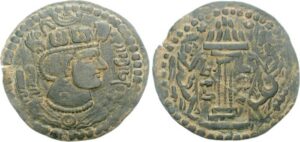
Coin of Turk-Shahi, King Tegin, Attribution: Classical Numismatic Group, Inc. Wikimedia commons.
It should be possible to identify coins from the museum if they were photographed and adequately described in museum publications. However, as far as the ACCG, IAPN and PNG know, there has been no effort on the part of the authorities to construct a comprehensive web site picturing the coins that were lost from the museum. The ANS has set up a program to allow coins suspected of coming from the Kabul museum to be donated for eventual return to the country. However, limited availability of documentation for the Kabul coins has made this project a difficult one to implement.
In 1992, an extremely large deposit of ancient coins and other objects was found by accident in a well in Mir Zakah village, 53 km northeast of Gardez. (This is not to be confused with the first Mir Zakah hoard from the national museum.) This hoard is said to have consisted of three to four tons of gold, silver or bronze coins (about 550,000 coins in total) and other precious metal objects.[31] The hoard was excavated during the period 1993-1995 by local people under the eyes of local militia commanders.[32] Researcher Osmund Bopearachchi viewed six sackfuls of coins in the Peshawar bazaar in Feb. 1994.[33] The hoard included some unusual types, including a coin of a hitherto unknown ruler of Iranian origin in India, Nasten.[34] However, the vast majority of the coins were common types duplicative of those already in published collections, and a large number also had limited appeal as collectibles due to corrosion from their long immersion in the water.[35]
Osmund Bopearachchi wrote of the Mir Zakah II hoard:
“The numerous coins in the Mir Zakah II hoard were mainly early Indian bent-bar and punch-marked coins from Greek, Graeco-Bactrian, Indo-Greek, Indo-Sythian, Indo-Parthian, and Kushana origins. Coins of the Indo-Scythian King, Azes II, and posthumous imitations of coins of Hermaeus comprised the largest proportion.”[36]

Mongol Great Khans coin minted at Balk Afghanistan AH 618-AD 1221 Minted for Abbasid Caliph al-Nasir, according to the Arabic inscription., Photographer PHGCOM, Collection of the British Museum, CCC-SA 3.0 unported license. Wikimedia Commons.
Presumably, coins currently on the market include coins from this enormous hoard. However, it would be impossible to tell merely from looking at any particular coin whether it originated from this hoard or whether it originated from an old collection or another country like Pakistan, India or some other nation in Central Asia. Certainly, corrosion would be an attribute of many Mir Zakah coins, but such a factor alone is not enough to ascertain with certainty if a coin came from this hoard.
In 1996, the Taliban, a militia organization under the leadership of conservative Mullahs, established control over the Pashtun dominated areas of Afghanistan, including Kabul. The Northern Alliance was pressed back to one corner of the country. Many of the Taliban were nationalists who wanted to protect their country’s heritage. Unfortunately, the movement soon became dominated by its most radical members supported by Osama bin Laden.
During this period, UNESCO red tape helped block an effort to remove remaining items from the Afghan National Museum to a museum in Switzerland for safe keeping even though the scheme had been endorsed by both the Taliban Minister for Information and President of the Northern Alliance. One of the reasons given was legal complications over the removal of objects from their country of origin under the 1970 UNESCO Treaty![37]
With UNESCO’s ludicrous stance hampering efforts to save the museum’s remaining artifacts, events soon took a tragic turn. On Feb. 26, 2001, the Taliban’s supreme ruler, Mullah Omar, issued an edict calling for the destruction of all pre-Islamic statues in the country. He is quoted saying, “As Islamic sharia [law] orders the destruction of statues and considers the drawing of portraits a mockery to the servants of Allah, the destruction of any site decorated with pictures is necessary.”[38] As a result of Omar’s edict, statuary still remaining in the National Museum was smashed and the magnificent Bamiyan Buddhas were dynamited. Had any coins been left in the Kabul Museum, it is safe to assume they would have been destroyed as well.
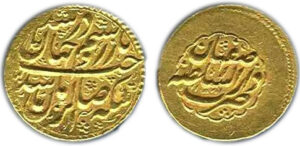
Afghanistan Hotaki Azad Khan Gold Mohur 11.0 grams; 1168 AH Isfahan Mint; Extremely Rare. Photo 25 April 2007, Wikimedia Commons.
During the war between the Taliban and the Northern Alliance, the looting of artifacts allegedly took place under the auspices of local war lords who sought funds to arm themselves. Looting also allegedly continues at sites around the country relying upon destitute farmers to act as diggers on behalf of local militia commanders. [39]
According to Feroozi and Tarzi,
“These sites of which I mention only few, have been subjected to illegal excavations by local commanders for the past twenty years, before the Taliban, after the Taliban, and are still being looted today.”[40]
The Case Against Emergency Import Restrictions.
There is no “emergency” as far as coins from Afghanistan are concerned. An “emergency” assumes some “immediate” danger. Here, Mujahideen commanders looted the Afghan National Museum of coins over 10 years ago, and any museum coins can only be traced accurately if they were photographed. Given the huge numbers involved, it is likely that many coins from the second Mir Zakah hoard can be found in trade; however, these also must have left Afghanistan over 10 [Ed. now 25] years ago, and indeed, given the circumstances at the time as well as the nature of the hoard, it is possible (and indeed probable) that the export was condoned (at least unofficially) by some authority associated with one or more competing governing factions in Afghanistan at the time.[41] Finally, while there is a high probability some of the Mir Zakha coins are found in the trade, there is no practical way to distinguish them from others that have been in the trade for decades. (i.e., some of the coins sold at auction from the 1830’s Masson collection).

Afghanistan, Second Anglo-Afghan War. Occupation of Qandahar. AH 1296-1298 / AD 1878-1880. Æ Fulus Bears a British crown within wreath on the obverse, and an Arabic inscription in four lines on the reverse. These issues were struck under local authorities who routinely recalled and devalued the coppers. This abusive practice lead to a great variety of types, often featuring various animal or flower motifs. Wikimedia Commons.
It is really only possible to find coins by design by using metal detectors. There are less intrusive means of discouraging coin hunters at Afghan archeological sites like limiting the use or availability of such devices.[42] In any event, it is not clear from the available literature that the current damage is being caused by coin hunters using such devices. Indeed, it is highly unlikely that metal detectors suitable for locating coins are widely available in such a poor country as Afghanistan (or Iraq for that matter).
Restrictions on the import of coins into the United States will not impact any looting in Afghanistan because it will not diminish the power of war lords or the destitution of farmers, the underlying cause of any problem. Nor will it impact the market in Pakistan where Afghan coins are sold freely with those found locally. Even worse, assuming restrictions do have their intended effect and make coins worthless as collectibles that will just make them more attractive to convert to bullion.[43]
Conclusion
Congress should authorize the preparation of a comprehensive and unbiased report about the nature, extent and causes of any looting in Afghanistan. It should also appropriate such monies as are necessary to construct a comprehensive website of items missing from the Kabul museum. Such a website should include descriptions and actual photographs of such items that are missing and not merely rely on generic listings.
[1] H.R. 4641, Cultural Conservation of the Crossroads of Civilization Act, introduced June 22, 2004. https://www.congress.gov/bill/108th-congress/house-bill/4641
[2] The Ancient Coin Collectors Guild (ACCG) is a nonprofit organization founded in response to efforts to restrict the public’s right to collect, preserve and study ancient coins. The purposes of the ACCG are to promote and nurture the free and independent collecting of coins from antiquity through education, political action and consumer protection. The goal of this guild is to foster an environment in which the general public can confidently and legally acquire and hold, for personal or professional use, any numismatic item of historical interest regardless of date or place of origin. The guild does not in any way support, condone or defend the looting of designated archaeological sites, nor the violation of any nation’s laws concerning the import or export of antiquities.
[3] The International Association of Professional Numismatists (IAPN) is a nonprofit organization of the leading international numismatic firms founded in 1951. The objects of IAPN are the development of a healthy and prosperous numismatic trade conducted according to the highest standards of business ethics and commercial practice. The IAPN has 112 member firms in 23 countries, including 35 in the United States. The Association’s Secretariat may be reached at 14, rue de la Bourse, 1000 Brussels, Belgium or P.O. Box 1057, Clifton, New Jersey 07014.
[4] The Professional Numismatists Guild (PNG) is a nonprofit organization founded in 1955. The PNG’s motto, “Knowledge, Integrity, Responsibility” continues to reflect its aims, and is expressed in the strict requirements for election to membership to the PNG. The PNG has over 300 members across the United States and abroad. The PNG may be contacted at 3950 Concordia Lane, Fallbrook, California 92028.
[5] Unlike Iraq, Afghanistan is not an Arab country and did not share Iraq’s Arab nationalism that helped prompt Iraq’s restrictive antiquities laws dating back to the 1930’s.
[6] In Iraq, the Ba’athist regime used history to aggrandize itself. Saddam Hussein was frequently depicted in the garb of hero from the past. Likewise, his crack “Republican Guard” divisions bore names associated with Iraq’s former glories. At the same time, antiquities trading was severely circumscribed unless one also happened to be a member of Hussein’s inner circle. (See Jeremy Lott, Found Objects: What Archaeologists Can Gain from Markets, or Lose by Ignoring Them, Reason online (Jan. 2004) (available at https://reason.com/2004/01/01/found-objects-2/.) (“The best story to emerge from the whole farrago is the fact that Hussein put his belly-dancing former mistress in charge of the antiquities market in the north. That must have been some shimmy.”); “Sale of Antiquities from Iraq Worries Archaeologists,” The New York Times News Service, June 24, 1996.)
[7] Letter from Turkish numismatist Bekircan Tahberer: “In my country, collecting ancients is a privilege because the right to own them is restricted. I am fortunate to have a license but the number of collectors is very limited. As a result nobody knows anything about ancient coins including archaeologists because it is forbidden to touch them without a license. They are not known and therefore are not appreciated, that is why the sites are looted and everything found are smuggled…. My only request is that you don’t restrict the freedom of private ownership of ancient coins because of this or that reason, which will restrict your society in return, as it has been doing in my country.”
[8] Primary Source: J. Cribb, B. Cook and I. Carradice, The Coin Atlas 163-167 (MacDonald & Co. 1990).
[9] Frank Holt, Alexander the Great and the Mystery of the Elephant Medallions 140 (University of California Press 2003).
[10] See Osmund Bopearachchi, Indo-Greek, Indo-Scythian and Indo-Parthian Coins in the Smithsonian Institution 13 (Smithsonian Institution 1993).
[11] Id.
[12] Peter K. Tompa (unattributed author), Mary Washington College Presents Symposium on Ancient Numismatics, American Numismatic Society Magazine 8, 10 (Spring 2002). To the extent archaeologists find hoards, they are usually small “purse hoards” of lost spending money fused together in the shape of a purse that disintegrated long ago.
[13] Letter from Alan Walker, The Celator, August 2003, at 4 (Walker helped author the excavation report for the site); Ann Johnson, Questions of Survival in R. Ashton and S. Hurter, Studies in Greek Numismatics in Memory of Martin Jessop Price 155 (Spink 1998).
[14] John Casey, Understanding Ancient Coins 88, (B. T. Batsford Ltd. 1986).
[15] Johnson, supra, at 155 n. 3.
[16] Elizabeth Errington, Discovering Ancient Afghanistan, The Masson Collection, Minerva Vol. 13 No. 6 at 53 (Nov./Dec. 2002).
[17] Id.
[18] Id.
[19] Reprinted in Whitehead, Indo-Greek Numismatics (Argonaut 1969).
[20] Johnson, supra, at 294.
[21] Private communications with several collectors and dealers who traveled to Afghanistan at the time.
[22] Source: Private communication with Dealer who lived in Afghanistan in the 1970’s.
[23] Id.
[24] Leo Mildenberg and Silvia Hurter, The Arthur S. Dewing Collection Nos. 2716-2731 (ANS 1985).
[25] Osmond Bopearachchi, SNG ANS Part 9 Greaco-Bactrian and Indo-Greek Coins (ANS 1998).
[26] Osmund Bopearachchi, Indo-Greek, Indo-Scythian and Indo-Parthian Coins in the Smithsonian Institution (Smithsonian Institution 1993).
[27] Source: Private Communication with Dealer that lived in Afghanistan in the 1970’s
[28] Nancy Dupree, Museum Under Siege, Archaeology Online (April 20, 1998) available at http://www.archaeology.org/online/features/afghan/index.html.
[29] Nabilla Ashrafi, National Museum Displays Thousands of Greco-Bactrian Era Coins, Tolo News 28 November 2019, https://tolonews.com/arts-culture/national-museum-displays-thousands-greco-bactrian-era-coins.
[30] Id.
[31] Osmund Bopearachchi, “Vandalized Afghanistan,” Vol. 19 No. 6 Frontline (Mar. 16-19, 2003). https://frontline.thehindu.com/arts-and-culture/heritage/vandalised-afghanistan/article30244351.ece: ; Statement of Abdul Wasey Feroozi and Zemaryalai Tarzi at the 105th Annual Meeting of the Archaeological Institute of America (Jan. 3, 2004), reprinted in The Impact of War upon Afghanistan’s Cultural Heritage 2 (March 2004).
[32] Feroozi and Tarzi, supra, at 2.
[33] Vandalized Afghanistan, supra.
[34] Id.
[35] Source: Private communication with coin dealer; See also Osmund Bopearachchi, “The Destruction of Afghanistan’s Cultural Heritage,” IIAS Newsletter March 2002 at 13.
[36] Osmund Bopearachchi, “The Destruction of Afghanistan’s Cultural Heritage,” IIAS Newsletter March 2002 at 13.
[37] Elspeth Moncrieff, “Red Tape Blocks Kabul Museum Salvage,” The Art Newspaper, vol. xii, no. 119 (November 2001).
[38] Archaeology on Line News, “Destructive Frenzy in Afghanistan,” (March 2, 2001) https://archive.archaeology.org/online/news/afghanistan/.
[39] See Feroozi and Tarzi, supra, at 17. The claim in H.R. 4641 Sec. 2, Finding 15 that looters are guided by copies of ancient maps appears to be another example of “hype.” (Source: Private communications with dealer who specializes in Central Asian art and dealer who specializes in Eastern Greek coinage.). However, it is suspected that various archaeological publications have acted as “guide books” for looters. (See Feroozi and Tarzi, supra. at 1 (noting that the Archaeological Gazette of Afghanistan became a good source for looters.); Private communications with the same dealers.)
[40] See Feroozi and Tarzi, supra. at 1 (noting that the Archaeological Gazette of Afghanistan became a good source for looters.); Private communications with the same dealers.
[41] See Feroozi and Tarzi, supra. 2 “The priceless treasure of Mir Zaka in the Paktia Province were illegally excavated from 1993-1995 by the local people and commanders with encouragement of Pakistanis and Afghan dealers.”
[42] Some countries, like Italy, ban the use of metal detectors in certain districts. Others, like the United Kingdom, regulate the use of metal detectors. The United Kingdom’s Treasure Act of 1996 requires metal detector finds to be reported. Museums are given a right of first refusal over finds. Finders receive a reward equal to fair market value if the state decides to keep a find for a museum. The law is a success because it recognizes that archaeologists are not the only “stake holders” in such issues. In particular, the law gives museums a right of first refusal, finders the prospect of a reward, dealers and collectors the prospect of access to coins with a demonstrable provenance, all while it also provides archaeologists with reports on finds that may lead to the discovery of otherwise unknown archaeological sites. ( See Peter A. Clayton, “Treasure: Finding Our Past,” Vol. 15 No. 1 Minerva 8 (2004).)
[43] Source: Private communication with coin dealer who specializes in Eastern Greek coins; Private communication with collector of Indian descent who indicated that he buys his coins from jewelers in India and thus saves them from the melting pot; Private communication with scholar who works in Turkey.
 Gold coin of Hormizd I, Afghanistan, Kushano-Sasanian, 3rd C CE. Copyright Trustees of the British Museum.
Gold coin of Hormizd I, Afghanistan, Kushano-Sasanian, 3rd C CE. Copyright Trustees of the British Museum. 

